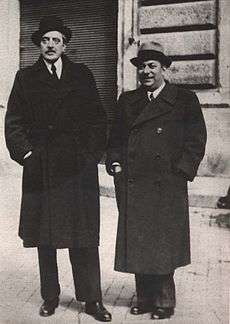Trilussa
Carlo Alberto Salustri (Rome, 26 October 1871 - 21 December 1950) was an Italian dialect poet, better known by his pen name of Trilussa (an anagram of his surname, “Salustri”). He is best known for his poems, some of them sonnets, written in the dialect of Rome.

Biography
Trilussa grew up very poor, as his father died when he was only three years old. He was a pupil of the Collegio San Giuseppe - Istituto De Merode from 1880 to 1886, first in the original location of Palazzo Poli at fontana di Trevi and then at the current location of piazza di Spagna where the school was relocated in 1885.[1]
Trilussa made a very early poetic debut in 1887 in the Rugantino magazine edited by Alfredo Zanazzo. Later he also wrote for Don Chisciotte, Capitan Fracassa, Il Messaggero and Il Travaso delle idee. His first collection, Le stelle de Roma ("Rome's Stars"), was written in 1889.
Trilussa's fame grew in the 1920s and 1930s though he was not a part of any literary circle, preferring instead to hang out in the streets and taverns which were the sources of his inspiration. His poetry features the petit bourgeoisie of Rome: the housewife, the store clerk and the servant but also contain strong satirical denunciations against governments and the vices of rich people. Some of the sonnets are Aesop-like moralistic fables. Trilussa's own sketches and drawings were featured alongside his poetry.
A very popular person in his city and Italy, Trilussa was named Life Senator on December 1, 1950, by the Italian President Luigi Einaudi. He died twenty days later.
In the work known as Illustrissimi, a collection of letters written by Pope John Paul I when he was Patriarch of Venice, Trilussa is one of the recipients of the letters.
Salustri was initiated to the Italian Scottish Rite Freemasonry[2], influencing the sonnets "Li framassoni de jeri" and "Li frammassoni de oggi"[3].
Selected bibliography
- Le stelle de Roma (1889)
- Quaranta sonetti (1895)
- Favole romanesche (1900)
- Caffè-concerto (1901)
- Er serrajo (1903)
- Ommini e bestie (1908)
- Le storie (1915)
- Lupi e agnelli (1919)
- Le favole (1922)
- Le cose (1922)
- La gente (1927)
Cinema
In 2013 the Italian programm RAI broadcast a TV miniseries about Trissula's life, Trilussa - Storia d'amore e di poesia, realized by Lodovico Gasparini.
See also
- Museum of Rome in Trastevere
References
- "Collegio S. Giuseppe - Istituto de Mérode" (PDF). Retrieved 20 December 2013.
- "From Belli to Totò and Gino Cervi, MASSONICamente narrows the Italian artist freemasons" (in Italian). Jan 2, 2016. Archived from the original on October 2, 2018. Retrieved Oct 2, 2018.
- "Trilussa and Freemasonry" (pdf). fiammacanicatti.it (in Italian). Archived (PDF) from the original on 2006-05-12. Retrieved Oct 2, 2018.
Sources
- Short Bio (with Trilussa’s sketches)
- Biblioteca Nazionale Braidense exposition
- Trilussa Poems